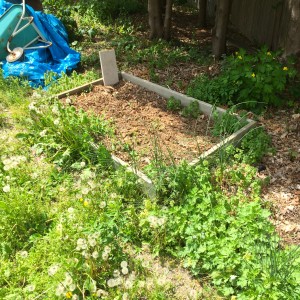It’s hard to believe that meaningful amounts of gardening can be accomplished in just 20 minutes. If there’s a trick, it’s learning to imagine what you can get get done and not over extending yourself. In the interest of transparency, Jan and I have started this series of posts about what 20 minutes looks like.
BEFORE:
We scavenged this sandbox frame from some neighbors a few years back whose kids had outgrown sand castles. (I don’t think I have yet.) When we turned it into a bed, we lined it with water permeable landscaping fabric, though we could have used corrugated cardboard which would have broken down in roughly the same amount of time. We filled box with compost. Yes, we could have use a mixture of compost and soil but we have the “problem” of generating more compost than we really “need.” Oh, the travails of a kitchen gardener. We mulch our beds heavily which accounts for the relative lack of weeds in this bed. We are “at war” with bindweed which I was particularly zealous in removing.
AFTER:
I focused on the bed. Jan snagged some lovely tomato sets at the Project Grow sale. Project Grow is worth a whole series of posts in itself but they fund some of their activities with an annual vegetable sale. Jan returned with peppers and tomatoes.
Ever since Jan got her Master Gardener status, she’s insisted that we at least *try* more or less to rotate the beds where we plant our “nightshades.” Tomatoes and peppers are in the same family as nightshade and if grown in the same location for too many years, harmful bacteria can build up in the soil. They also tend to be heavy feeders. This year, tomatoes are in the Sandbox.
Let me sing the praises of weeding in a bed of crumbly, well mulched soil. The weeds largely lifted out with their root systems intact. The notably exception being bindweed which snaps off after about six inches, fleeing to fight again another day. Bindweed spreads remarkably well from even a small snippet. We make sure any bindweed is well dead and composted. How? We have a round flagstone clearing where we pile weeds after shaking loose any soil. After a few days in the sun, they are wilted and have given up the ghost enough that we feel we can add them to our compost pile. (Some fear overly adding weed seeds to their compost but in our experience, a properly assembled compost pile “cooks” at high enough temperature to sterilize most seeds. The weed seeds that stay viable are “discouraged” by our all-over mulch. You Mileage May Vary.)
I usually put up some kind of “cage” when I put plants in… even if I will likely use the tomato spirals eventually. My mother joked that putting a tomato cage over a spindly little seeding might discourage it, but I prefer to think I’m giving the sprouts something to shoot for. Y’know, the reach exceeding grasp else what’s a heaven for, type of thing. Also, I reminds ME that I’ve planted something in a given bed. Yup, on more than one occasion I have enthusiastically “weeded” out seedlings that I forgot I’d planted previously.
The only bit of “cheating” shown here is that Jan was running the lawn mower as I weeded so I was able to mulch some of the tomatoes just after I planted them. The crumbly friable soil was so loose I didn’t need a trowel to excavate a hole but I did moisten the holes with a bit of water. I left the identifying plastic tags by each tomato. Later, maybe tonight during a garden walk, I’ll collect them and note which kind of tomato is where in the garden journal. You DO keep a garden journal, don’t you? It’s a great way to keep track of details from year to year.
Weeding the path is another thing altogether. The previous own put in this snaking path that is quite lovely. It resists weeds for the most part but the ones that do manage to get a foothold are particularly devilish to extricate. For the most part, the weeds in the path have extremely shallow roots, since the path has a dense base. The bigger weeds can be pulled normally. For smaller ones, I have developed a technique of rubbing my fingers through the gravel back and forth. The roots are dislodged and magically collect in my fingers while the gravel is lightly scattered. I might make a video about it at some point if that description is too vague. Honestly though, I intend to use a propane torch later in the season to toast the roots of these path weeds. I read about it on Tobias Buckell’s blog a couple years back and it’s exactly the kind of “lazy gardener” trick I adore.
That’s it. 20 minutes.




